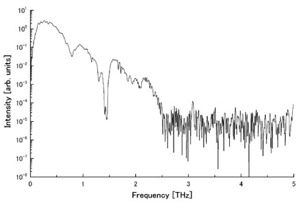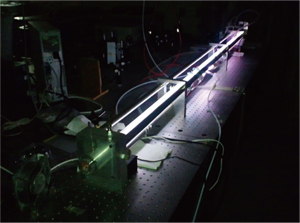Odashima, Hitoshi Professor
 |
To the group homepage
http://www.isc.meiji.ac.jp/~hoda/index.htm
|
Academic Degree
PhD (Science), University of Tokyo, Japan
|
Membership in Academic Societies
The Physical Society of Japan
The Japan Society of Applied Physics
|
|
Research Interests
(i) Terahertz (THz) spectroscopy
 |
|
Fig.1. THz spectrum of glucose
|
 |
|
Fig.2. CO2 laser for trapping microparticle
|
The terahertz (THz) spectral region was sometimes called the gap in the electromagnetic spectrum because it was difficult to produce tunable, coherent terahertz radiation. Recent development of semiconductor and laser technologies, however, enables us to generate and control terahertz-waves more easily. Our laboratory employs two types of terahertz spectrometers. One is based on terahertz time-domain spectroscopy (THz-TDS), and a single measurement with it gives the whole spectrum of the 1-3 THz region (Fig.1.). We currently observe the spectra of biologically-relevant molecules such as sugar groups and amino acids. The other spectrometer, which is based on the difference frequency of two near-infrared semiconductor lasers, provides high-resolution spectra of gas-phase molecules such as methanol and water vapor. Quite recently, we also have begun to combine these spectrometers with manipulation of microparticles and molecules to improve the resolution of observed spectra (Fig.2.).
(ii) Laboratory spectroscopy of interstellar molecules
Electromagnetic spectra from interstellar space contain a number of lines assigned to transitions of molecules such as CH
3OH, C
2H
5CN, HCOOCH
3, and CH
3OCH
3. The internal rotation of the methyl group in these molecules makes the observed spectra very complicated. The spectroscopic study of these molecules in the laboratory is necessary for analysis of the interstellar spectra to obtain information on physical conditions of the circumstances and on chemical reactions in the interstellar space.
Selected Publications
- H. Odashima, S. Merz, K. Enomoto, M. Schnell, and G. Meijer, “Microwave Lens for Polar Molecules”, Phys. Rev. Lett. 104, 253001 (1-4), (2010).
- H. Odashima, M. Tachikawa, and K. Takehiro, “Mode-Selective Thermal Radiation from a Microparticle”, Phys. Rev. A80, 041806 (1-4), (2009).
- H. Odashima, “The Breakdown of the Born-Oppenheimer Approximation for Protonated Rare Gas Ions”, J. Mol. Spectrosc. 240, 52-57, (2006).
- H. Odashima, K. Ogata, Y. Karakawa, K. Takagi, and S. Tsunekawa, “Analysis of Rotational Transitions of Methyl Formate in the Ground and First Excited Torsional States”, Molecules 8, 139-145, (2003).
- H. Odashima, L. R. Zink, and K. M. Evenson, “Tunable Far-Infrared Spectroscopy Extended to 9.1 THz”, Opt. Lett. 24, 406-407, (1999).
- H. Odashima, F. Matsushima, K. Nagai, S. Tsunekawa, and K. Takagi, “Far-Infrared Spectroscopy of Methanol Using a Tunable Coherent Radiation Source”, J. Mol. Spectrosc. 173, 404-422, (1995).











